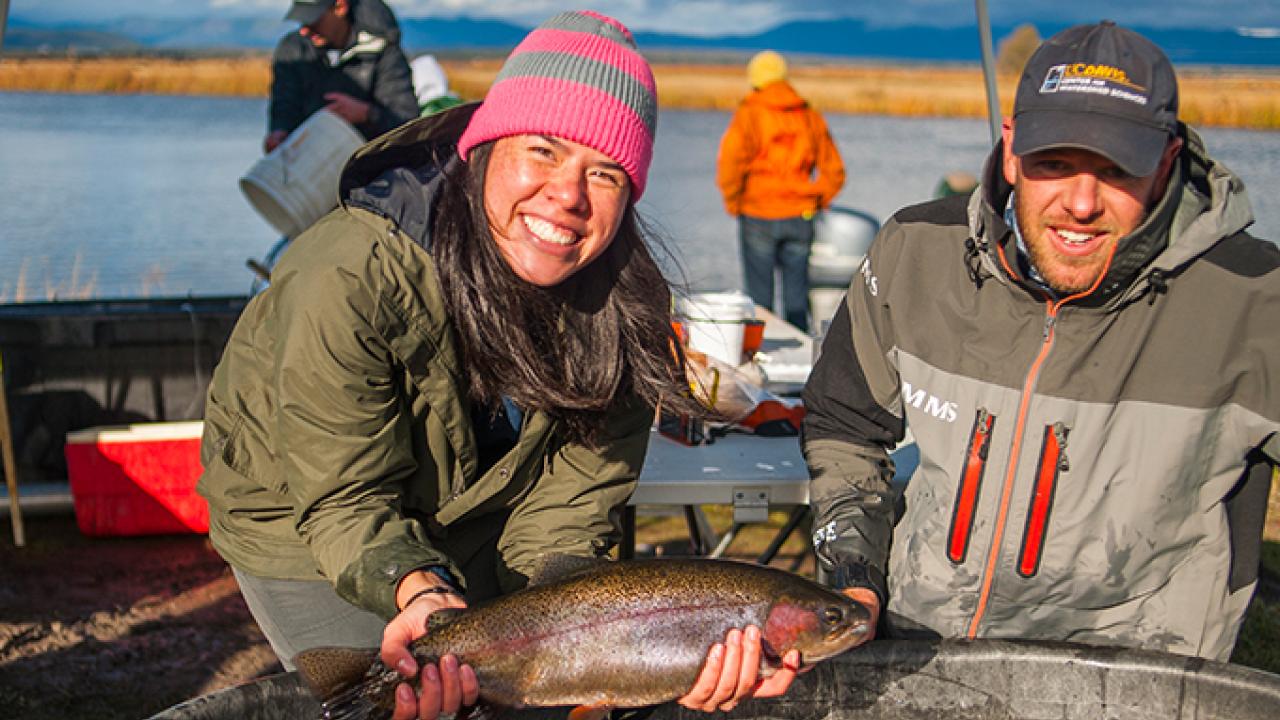
A Fish Story
“Native fish in California are imperiled throughout the state,” said Carson Jeffres, field and lab director at the UC Davis Center for Watershed Sciences. “During the drought, we saw a dramatic change in the aquatic habitats that were available.”
Fall River Native Trout Project
Since 2012, researchers at the Center for Watershed Sciences have worked in partnership with CalTrout, the California Department of Fish and Game, the Fall River Conservancy and others to investigate the native rainbow trout fishery on the Fall River north of Mt. Lassen.
The Fall River is the largest spring-fed river in California, relying on fresh water burbling up from aquifers underground. Spring-fed rivers often have unique water chemistry that promotes the growth of aquatic plants and insects. In addition to spring water, the Fall River also receives some surface water contributions from Bear Creek, a tributary fed by rainfall and snowmelt.
“There’s been a lot of anecdotal evidence about the decline of the fishery in the area around Fall River,” said Andrew Braugh of the nonprofit conservation organization CalTrout, which funds the research. “We wanted to see if there was data to support that.”
Tracking movement
To gather data on the rainbow trout populations in the Fall River, researchers insert tiny PIT tags—short for Passive Integrated Transponder tags—into each fish to give it a unique identification code.
“Essentially, we put a tracking device in them, and we have antennae set up in the watershed,” said fish biologist Jeffres. “Every time a tagged fish swims by, the identification code is radio transmitted. It’s just like your car going through the toll plaza when you drive over the bridge. Our receiver notes that this specific fish passed this location at this specific time.”
The PIT tags allow researchers to see how the fish migrate through the system and give them a long-term look at changes over successive years.
Tagging trout
The actual process of tagging trout is a slippery business.
Twice a year, Jeffres and a group of volunteers gather at the Fall River to help process fish from dawn until dusk. Collaborators include geneticist Michael Miller, a professor in the UC Davis Department of Animal Science, who handles the genetic aspects of the research project. In addition, the California Department of Fish and Game brings boats and equipment to round up the trout and safely return them to the river after tagging.
Joining researchers are student volunteers, representatives from CalTrout, as well as local conservationists. This year, even the dean of the College of Agricultural and Environmental Sciences, Helene Dillard, came and pitched in on the fish-tagging work.
Volunteers work quickly to measure each fish, insert a PIT tag, take a tiny clip of fin for genetic data, get a photo of the fish, and slip it into the recovery tank before it’s returned to the river.
Undergraduate Dana Myers, who interns with the Center for Watershed Sciences, participated in her first tagging expedition this year.
“I was really looking forward to tagging, and it lived up to my expectations,” said Myers, a junior majoring in environmental science and management. “I had never held a live fish in my hands before! It was so cold that I lost feeling in my hands and feet, but everyone worked together really well and joked around and made it a fun environment. It was one of the best fieldwork experiences I’ve had.”
Two populations of rainbow trout
This fall the team on the Fall River tagged more than 270 trout, adding to the long-term data set that helps track changes in the fishery over time.
Researchers have discovered that with two primary sources of water, the Fall River supports two populations of rainbow trout. One group spawns in the spring-fed portion of the river and made up about 70 percent of the fish population in 2012. The other group of trout—the remaining 30 percent—heads upstream to Bear Creek to spawn. There are nearly 25 miles between the source waters and the dam at Fall River Mills, which gives the fish lots of room to roam.
“When the two populations aren’t spawning, they’re completely mixed in the river,” said Jeffres. “Then they segregate to spawn. Genetically, they’re very different.”
Changes during the drought years
Researchers found that during the drought years that peaked between 2012 and 2015, the population of trout that spawn in Bear Creek decreased dramatically as the surface waters diminished. “The Bear Creek trout population dwindled to almost nothing,” said Jeffres.
Researchers also determined that the spring-fed population of rainbow trout in the Fall River remained stable during the drought years.
“One important lesson from this research is that native fish living in spring-fed systems survive during drought because their habitat is more resilient,” said Jeffres. “From a conservation perspective, these are the types of habitats you want to conserve and manage into the future. These are the places that are going to maintain our native plants and animals under a changing climate through flood and drought.”
Ongoing research
The fish tagging project on the Fall River is ongoing with the support of CalTrout. One question researchers will investigate is how the creek-fed rainbow trout population rebounds after last year’s rainfall and the change in drought conditions.
“Gathering this type of data is critical because the science informs future water management decisions,” said Braugh of CalTrout. “This is an example of what can happen with a partnership between universities, agencies and organizations when everyone works together and brings their unique skill set.”